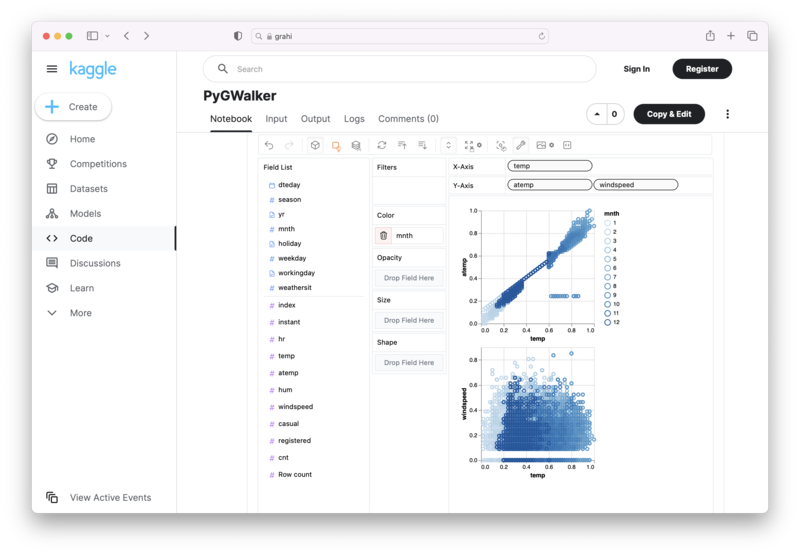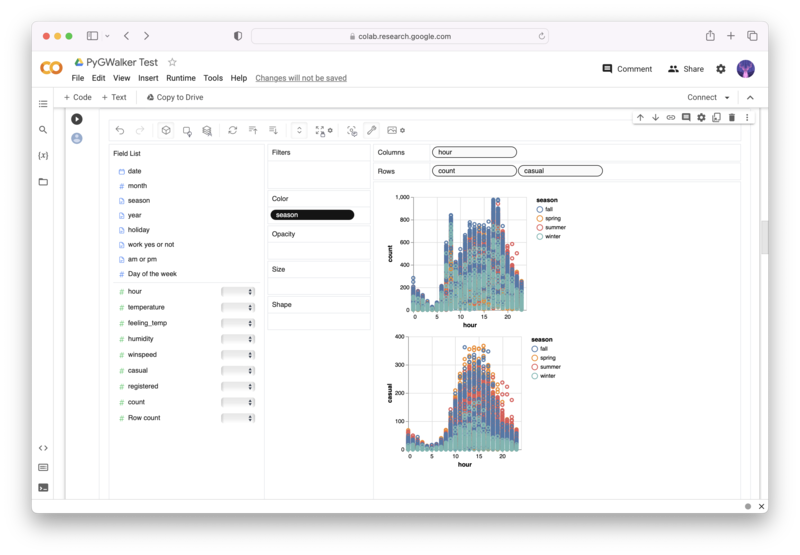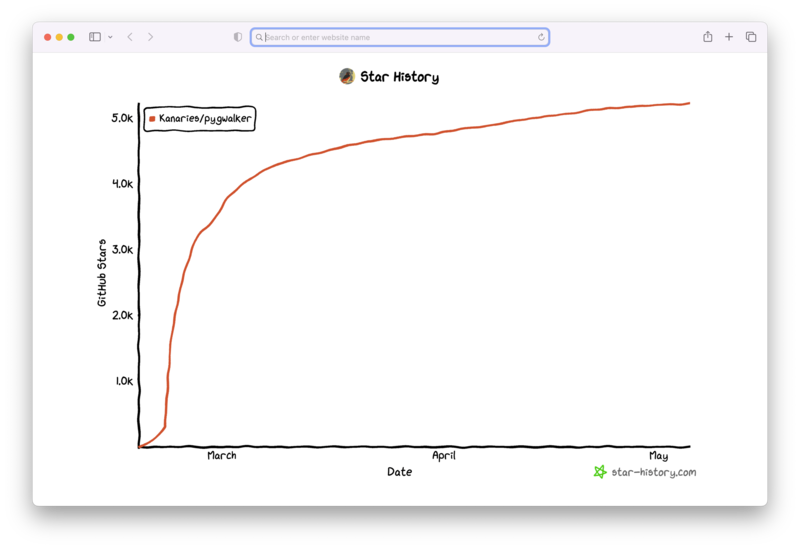What's New in Pandas 2.0? A Comprehensive Guide to the Latest Features, Use Cases, and Best Practices
Published on
Data scientists and analysts worldwide rely on Pandas, the powerful Python library for data manipulation and analysis. With the release of Pandas 2.0, users can explore new horizons and take their skills to the next level with the latest features and best practices.
In this comprehensive guide, we'll explore the key improvements in Pandas 2.0, tips and tricks for better use, and a range of use cases across machine learning, time-series data, and data visualization.
Want to quickly create Data Visualizations in Python?
PyGWalker is an Open Source Python Project that can help speed up the data analysis and visualization workflow directly within a Jupyter Notebook-based environments.
PyGWalker (opens in a new tab) turns your Pandas Dataframe (or Polars Dataframe) into a visual UI where you can drag and drop variables to create graphs with ease. Simply use the following code:
pip install pygwalker
import pygwalker as pyg
gwalker = pyg.walk(df)You can run PyGWalker right now with these online notebooks:
And, don't forget to give us a ⭐️ on GitHub!
FAQ about Pandas 2.0
Q1. What is Pandas 2.0?
Pandas 2.0 is the latest version of the popular Python library for data manipulation and analysis. It builds on the strengths of previous versions and introduces a range of new features for easier and more effective data wrangling.
Q2. What are the significant improvements of Pandas 2.0?
Pandas 2.0 brings a host of performance enhancements, including improved memory usage and query execution speed. The new release also includes native support for nullable data types, enabling faster and more flexible data analysis.
Another notable feature is the integration of Apache Arrow as the default memory format, providing faster and more efficient data transfer between systems.
Q3. How can I upgrade to Pandas 2.0?
To upgrade to Pandas 2.0, you can use the standard pip package manager with the command:
pip install pandas --upgradeAlternatively, you can download the latest version of the library from the official website and install it manually.
Q4. What are some use cases for Pandas 2.0?
Pandas 2.0 is a versatile tool that can be used across a wide range of use cases, including:
- Data analysis and visualization
- Time-series data analysis
- Machine learning tasks
- Data manipulation and wrangling
- Managing large datasets for efficient analysis
Q5. What are the best practices for using Pandas 2.0?
To use Pandas 2.0 effectively, there are a few best practices to keep in mind:
- Use vectorized operations rather than loops for faster performance
- Avoid using chained indexing, which can lead to unpredictable results
- Leverage the power of built-in and external functions for efficient data manipulation
- Choose the appropriate data structures for your use case to optimize memory usage
- Handle missing or null data appropriately, using the new nullable data type features in Pandas 2.0
- Explore the variety of data visualization options available in Pandas 2.0 for clear and informative visuals
Pandas 2.0 vs other data analytics libraries
While Pandas 2.0 is a powerful tool, it's not the only Python library available for data analysis. Other popular options include NumPy and SciPy, which specialize in scientific computing applications, and Scikit-Learn, which focuses on machine learning tasks.
However, Pandas distinguishes itself for its ability to handle tabular data effectively, including the ability to handle missing or incomplete data and support for data operations based on column and row labels.
In terms of performance, the improvements in Pandas 2.0 have boosted its speed and efficiency, making it a capable contender for many data analysis and manipulation tasks.
How to improve Pandas 2.0 performance
While Pandas 2.0 has much-improved performance over previous versions, there are still techniques you can use to optimize your use of the library. Some tips for improving performance include:
- Use .loc or .iloc for efficient indexing rather than boolean indexing
- Use the inplace parameter to modify data frames without making copies
- Use native Python operations instead of Pandas methods when possible
- Use the appropriate data structures for your use case, such as using Series instead of DataFrames for single columns of data
Introduction to nullable data types in Pandas 2.0
Nullable data types are a new feature in Pandas 2.0 that allow for more flexible handling of missing or null data. Instead of using NaN, nullable data types use a bitmask to flag missing data, leading to faster and more efficient data analysis.
To use nullable data types, you can convert a column to the 'Nullable' dtype using the astype() method. This will allow for more flexible use of the data without encountering unexpected errors due to missing data.
Using Pandas 2.0 for time-series data analysis
Pandas 2.0 is an excellent tool for analyzing and manipulating time-series data, such as from financial or sensor data sources. The library includes built-in functions for time-based indexing and operations, allowing for easier manipulation of time-series data.
Additionally, Pandas 2.0 includes a range of time-series data visualization tools, such as plotting tools and data grouping options. This makes it easy to explore patterns and trends in your time-series data at a glance.
Pandas 2.0 and Apache Arrow backend
Apache Arrow is a widely-used memory format for efficient data transfer between systems. With Pandas 2.0's integration of Apache Arrow as the default memory format, users can enjoy faster data loading and data transfer times.
Additionally, the integration with Apache Arrow enables seamless conversion between different data sources and formats, allowing for faster and more efficient data manipulation and analysis.
How to handle missing data in Pandas 2.0
Handling missing or null data is a common challenge in data analysis, but with the introduction of nullable data types in Pandas 2.0, users have a more flexible way to handle missing data.
To handle missing data effectively in Pandas 2.0, you can use functions like dropna(), fillna(), and interpolate() to remove, replace, or interpolate missing values. Additionally, you can convert the column to a nullable dtype to optimize the handling of missing values.
Pandas 2.0 for machine learning tasks
Pandas 2.0 is an excellent tool for machine learning tasks, with a wealth of built-in functions and support for a variety of data structures. The library includes functions for data normalization, encoding, feature selection and engineering, and more.
Additionally, Pandas 2.0's integration with Apache Arrow and support for nullable data types makes it efficient and flexible for handling the large datasets commonly used in machine learning tasks.
Tips and tricks for using Pandas 2.0 effectively
To get the most out of Pandas 2.0, consider these tips and tricks:
- Avoid using for or while loops, and use vectorized operations instead for improved performance
- Use descriptive column labels for easier readability and organization
- Use the info() method to get quick summaries of your data frames
- Use the built-in and external functions for efficient data manipulation and analysis
- Take advantage of the data visualization tools available in Pandas 2.0 for clear and informative visuals
Pandas 2.0 for data visualization
Pandas 2.0 offers a range of data visualization options, from basic plots to more complex charts and graphs. Users can choose from a variety of styles and palettes and customize their visuals to achieve the desired effect.
In addition, users can leverage the built-in support for visualizing time-series data and other specialized data structures, making it easy to explore patterns and trends in their data at a glance.
Pandas 2.0 and data manipulation hacks
Pandas 2.0 is a powerful tool for data manipulation, but there are some lesser-known hacks and tricks that can make your life even easier. Some of these include using the .replace() method to quickly replace values in a data frame, using the .pivot_table() method for easy data aggregation and grouping, and using boolean indexing for efficient filtering of data frames. With a little practice and exploration, you'll be on your way to data manipulation mastery!
Conclusion
With the release of Pandas 2.0, data scientists and analysts have a powerful new tool to help them take their skills to the next level. By exploring the new features and best practices outlined above, you'll be well on your way to data manipulation and analysis mastery. So why wait? Upgrade to Pandas 2.0 and start exploring today!
More Pandas Tutorials:


